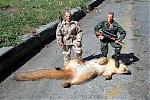Has anyone taken a look at the paper "Increasing Small Arms Lethality in Afghanistan: Taking Back the Infantry Half-Kilometer" by MAJ Thomas P. Ehrhart? From what I have heard it has caused something of a stir within the US Army. The debate over replacing US infantry weapons and marksmanship training has gone on for a little, but here someone has finally put it into a serious thesis.
If anyone has taken a serious look at it, what are opinions?
Here's the pdf link.
http://www.dtic.mil/cgi-bin/GetTRDoc...c=GetTRDoc.pdf
Also, here is an abstract of his paper. Sums up the intent pretty well.
Once again, any thoughts?Operations in Afghanistan frequently require United States ground forces to engage and destroy the enemy at ranges beyond 300 meters. While the infantryman is ideally suited for combat in Afghanistan, his current weapons, doctrine, and marksmanship training do not provide a precise, lethal fire capability to 500 meters and are therefore inappropriate. Comments from returning soldiers reveal that about fifty percent of engagements occur past 300 meters. Current equipment, training, and doctrine are optimized for engagements under 300 meters and on level terrain. This monograph reviews the small arms capability of the infantry squad from World War I to present. It then discusses current shortfalls with cartridge lethality, weapons and optics configurations, the squad designated marksman concept and finally the rifle qualification course. Potential solutions in each of these areas are discussed.
















 ).
).

Bookmarks